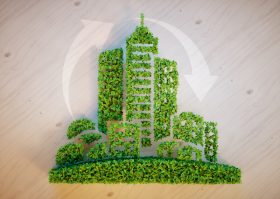
Before the pandemic hit, momentum was building to fight climate change, said Eli Angen, a principal in responsible investing, strategy and risk at the Ontario Teachers’ Pension Plan.
At the Canadian Investment Review’s 2020 Global Investment Conference in September, Angen pointed to the decreasing cost of the energy transition and greater societal and business awareness about climate change.
“Sustainable investing has been on a bit of a tear between 2012 and 2018,” he said, noting according to data from the Global Sustainable Investment Alliance, global sustainable investments have grown from about $13.3 trillion to $30.7 trillion.
When the world locked down in response to the coronavirus, people stopped flying and driving and the total energy demand across the world decreased substantially, he added. However, emissions are starting to rise again.
When it comes to the recovery, if the world doubles down on sustainability, the emissions decrease can be permanent, Angen noted. “But if you aren’t really focused in how you build back, then you just tend to get a rebound into the behaviours we previously had, and even an exacerbation, because people may not be comfortable with transit. So if everyone’s going back to the office, you’ll see an uptick in driving.”
From the perspective of the Ontario Teachers’ Pension Plan, many portfolio companies have been hit hard by the pandemic and the focus has been keeping the lights on, Angen said. However, despite the shift in priorities, ESG still remains an area of focus for the pension plan and many other investors. He pointed to a Mercer survey from 2020, for example, that found a dramatic increase in the number of investors considering integrating ESG in their investment process.
The recovery’s direction coming out of the coronavirus with regards to ESG depends on government actions, Angen said.
“[China is] always an important part of this conversation and I see two stories playing out here in competition,” he noted. “On the one hand, traditionally, to stimulate GDP they have doubled down on heavy industry, coal-fired power, steel, cement, things like that. Regional governments are very familiar with how you deploy that capital, how you get that support out to people and get that economic movement. On the other hand, the development that they’ve had has meant that they have a much larger middle class and that middle class is far less tolerant of the health and environmental impacts, especially the air pollution health impacts, because that’s such a direct day-to-day problem. And so there’s a much greater push back the other way to phase those out to invest more in the renewable energy, more in [electric vehicles] and more in the clean energy future. It remains to be seen where that shakes out.”
What countries like China and the U.S. do when it comes to the economic recovery is going to set the stage for the coming decade of the energy transition. “It’s really important to track what’s happening there, because it will be the biggest determinant.”
Overall, the coronavirus response has shown how fast the world can move. “While the emission drop that you’ve got because of a shutdown and economic activity is very much not how you would want to try to address climate change, it does give you a sense that we can cause those sorts of dramatic societal shifts that are required to address climate change. So [COVID-19] has, to a degree, kind of opened the window to how dramatic the change can be and that we are capable of doing that.”
